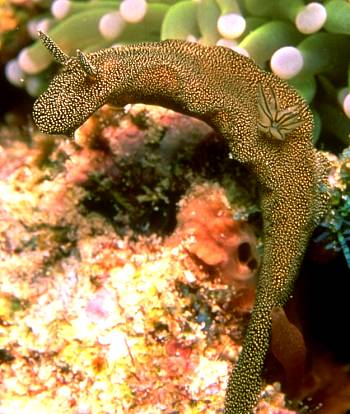
Glossodoris stellatus
Rudman, 1986
Order: NUDIBRANCHIA
Suborder: DORIDINA
Superfamily: EUDORIDOIDEA
Family: Chromodorididae
DISTRIBUTION
Known from Papua New Guinea, Indonesia, Malaysia.
PHOTO
Sipadan, Malaysia, 9 May 1992 Photo: D.J.W.Lane.
Very characteristic dark brown to black background colour with the whole body covered in small white specks. The body is relatively hard and the mantle edge [or skirt] is very reduced much like some species of Ceratosoma. Behind the gills the mantle edge fuses in to the long raised posterior part of the foot. The name stellatus is from the Latin word for 'starry' and refers to the colour of the animal. Hopefully the sky still looks like this in some parts of the world.
Reference:
• Rudman,WB (1986) The Chromodorididae (Opisthobranchia: Mollusca) of the Indo-West Pacific: The genus Glossodoris Ehrenberg (= Casella, H. & A. Adams). Zoological Journal of the Linnean Society, 86(2): 101-184.
Rudman, W.B., 2002 (May 2) Glossodoris stellatus Rudman, 1986. [In] Sea Slug Forum. Australian Museum, Sydney. Available from http://www.seaslugforum.net/find/glosstel
Related messages
Glossodoris stellatus from Sulawesi
February 6, 2007
From: Ken Tucker
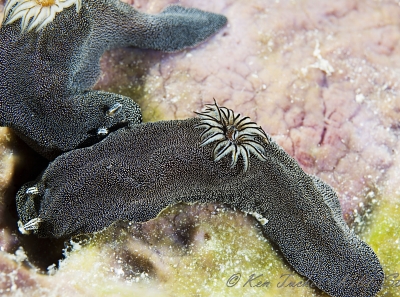
I thought this photo of Glossodoris stellatus would make a nice addition to the thread.
Locality: Bunaken Park - Batu Lohang, 10 metres, Indonesia, Sulawesi, 17 Nov 2006. Length: 8 cm. Photographer: Ken Tucker.
Ken Tucker
ken@kilili.com
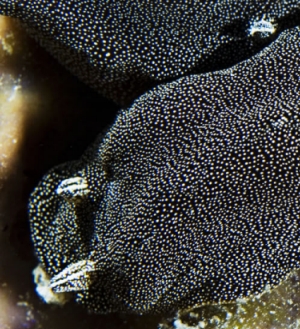
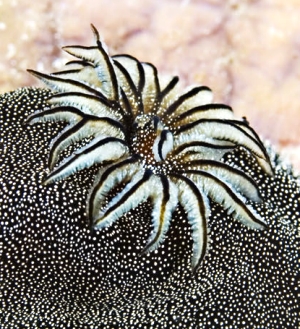
Dear Ken,
Thanks for another record of this species. Earlier messages have suggested it is usually found associated with a food sponge. Would you by chance have any other photos which may show them eating a sponge?
Best wishes,
Bill Rudman
Re: Glossodoris stellatus in Papua New Guinea
July 13, 2005
From: Roberto Sozzani
Dear Bill,
Following Mary Jane Adams' message [#13505] I confirm I've always seen Glossodoris stellatus, in Indonesia, on the underside of this sponge (probably Phyllospongia lamellosa), often with the same yellow egg coils shown on Mary Jane Adams' second message [#13506]. I must add that Glossodoris stellatus is not the only nudibranch I've seen on this sponge: I've spent few night dives looking only under these sponges and I remember I saw some small species I couldn't identify. I'll try to find the photos and send you a copy.
Best regards
Roberto Sozzani
www.robertosozzani.it
roberto.sozzani@fastwebnet.it
Sozzani, R., 2005 (Jul 13) Re: Glossodoris stellatus in Papua New Guinea. [Message in] Sea Slug Forum. Australian Museum, Sydney. Available from http://www.seaslugforum.net/find/13586Dear Roberto,
I'm sorry I didn't post this message earlier - I thought I had. Your message on Glossodorissp. 14 [#14225] reminded me. Any photos of an animal on its sponge would be a valuable record
Best wishes,
Bill Rudman
Glossodoris stellatus in Papua New Guinea [1]
April 18, 2005
From: Mary Jane Adams
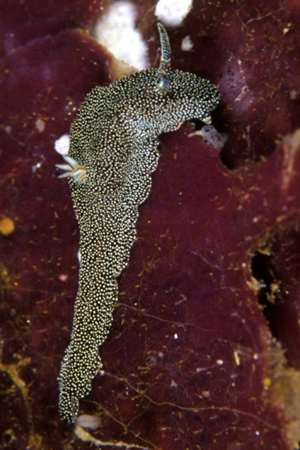
Dear Bill,
After making hundreds of dives in Papua New Guinea without seeing a single Glossodoris stellatus, I thought they must be really rare. I recently learned that I just wasn't looking in the right place. On a trip to Milne Bay in October 2004 I asked PNG diving pioneers Bob and Dinah Halstead if they knew where I might find this species. They told me that they lived on the underside of a certain foliose sponge. With that information I was able to find dozens of them on reefs around the D'Entrecasteaux Islands and along the North Coast of Milne Bay. The sponge is very common and easy to recognize. The upper side is purple, but sometimes appears gray or green due to overgrowth of algae, hydroids, etc. The underside is darker and more reddish purple. The sponges are quite tough and leathery, but flexible enough to bend easily in a slight current. Some colonies grow strait out from the reef in a semi-circle. (lower right) Other colonies have a relatively narrow base that branches into many lobes. (lower left).
Although these sponges were seen on most divesites in Milne Bay, the ones where I found G. stellatus were on vertical or nearly vertical walls. The sponges that had G. stellatus under them were fairly clean. I never saw any G. stellatus on sponges that were heavily overgrown with other organisms. The highest concentration of G. stellatus I saw was on Balaban's Bommie near the northwest corner of Normanby Island. On this divesite there was a dense cluster of these foliose sponges on a vertical wall. On 22 Oct. 2004, I found G. stellatus under about 15% of these leafy sponges at a depth of 10-15 meters. A few sponges had two slugs and one had four. [see #13506 ]. Even in areas with a high concentration of G. stellatus, I never saw any that weren't on sponges, however Mike Miller did find one crawling on rubble patch near Sanaroa Island.
The Glossodoris stellatus specimens I saw all looked nearly alike. They were dark brown to charcoal black with tiny, close-set, white dots and a crawling length of 50 -70 mm. I also saw many yellow egg coils on the underside of the host sponges. I never observed a slug laying these eggs, but another diver in my group did. The coils measured 20-24 mm across and as best as I can measure, the eggs are about 170 microns in diameter [see #13506 ].
The slugs seemed to be grazing on the sponge, but I couldn't tell for sure underwater. However, one of my photos (upper right) shows a patch of sponge near the anterior end of the slug that appears to have been scraped away. The fact that they prefer bare sponges to those with other organisms growing on them indicates to me that the sponge itself is their food. The slugs were always on the underside, near the center or base of the sponge where they were best concealed. However, their egg coils were always very near the edge of the sponge where they would be exposed to the most water movement. When I pulled specimens off the sponges I noticed that they held on with a Velcro-like grip that had to be peeled away bit by bit. A sticky foot is certainly useful for a slug that lives its life upside down. In one photo [see #13506 ] I noticed two rows of light brown spots on the mantle. Are these are poison glands?
Locality: Milne Bay Province, Papua New Guinea, Pacific Ocean. Depth: 10-25 meters. Length: 50 -70 mm. Oct. 2004, Jan. 2005. Coral Reef. Photographer: M. J. Adams.
Best regards,
Mary Jane
divepng@yahoo.com
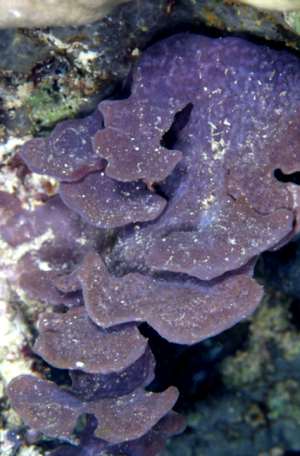
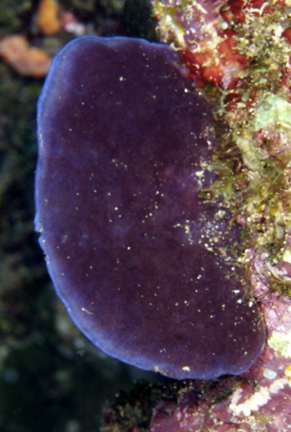
Dear Mary Jane,
Thanks for this valuable information. This sort of knowledge about individual species is not available in textbooks and seldom found in scientific papers. I am sure the marks you can see are signs of it feeding, and its constant association with this sponge is a good indication that this is indeed its food sponge. I am pleased to say our sponge identification exercise is very close to completion, and finding G. stellatus on this sponge complements the data we have on Glossodoris species.
The light brown spots in two rows in your photo [see #13506 ] are indeed the mantle [poison] glands. This is an interesting addition to our knowledge as I was unable to find the glands in earlier studies (Rudman, 1986). In that study I could divide the species of the genus Glossodoris into at least 3 subgroups on the basis of various external and internal anatomical features. Glossodoris stellatus belonged in the 'G. atromarginata subgroup' on the basis of general shape (hardened body, reduced mantle skirt, radular morphology etc). It is nice to see that the position and type of mantle glands is identical to that of G. atromarginata, certainly supporting the possibility that the genus Glossodoris may need an overhaul when we have more material available.
Best wishes,
Bill Rudman
Glossodoris stellatus in Papua New Guinea [2]
April 18, 2005
From: Mary Jane Adams
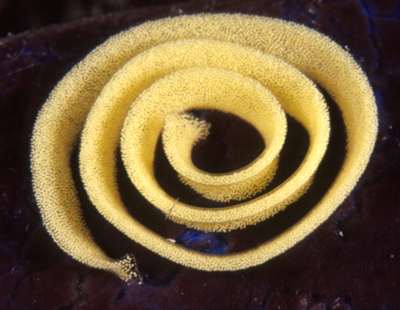
Here are 3 more photos to accompany Mary Jane Adams' message [#13505] about Glossodoris stellatus in Papua New Guinea.
Upper Right: "I also saw many yellow egg coils on the underside of the host sponges. I never observed a slug laying these eggs, but another diver in my group did. The coils measured 20-24 mm across and as best as I can measure, the eggs are about 170 microns in diameter."
Lower Left: " The highest concentration of G. stellatus I saw was on Balaban's Bommie near the northwest corner of Normanby Island. On this divesite there was a dense cluster of these foliose sponges on a vertical wall. On 22 Oct. 2004, I found G. stellatus under about 15% of these leafy sponges at a depth of 10-15 meters. A few sponges had two slugs and one had four".
Lower Right: " In one photo [#13506 ] slide #43700a I noticed two rows of light brown spots on the mantle. Are these are poison glands?"
Locality: Milne Bay Province, Papua New Guinea, Pacific Ocean. Depth: 10-25 meters. Length: 50 -70 mm. Oct. 2004, Jan. 2005. Coral Reef. Photographer: M. J. Adams.
Best regards,
Mary Jane Adams
divepng@yahoo.com
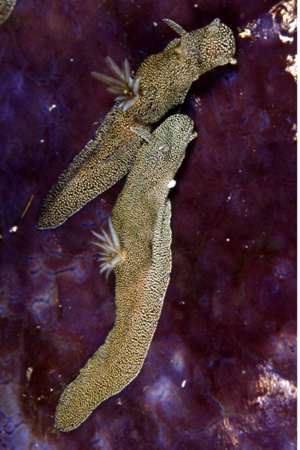
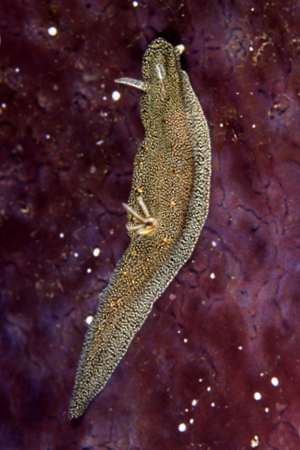
Glossodoris stellatus from Sipadan, Malaysia
June 24, 2003
From: Alice Lee
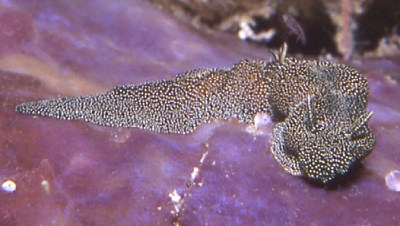
Hi Bill,
Can you help to identify this chromodorid nudibranch.
Location: Sipadan, Malaysia
Depth: <10m
Size: 4cm
Thanks.
Alice Lee
alee@dlink.com.sg
Lee, A., 2003 (Jun 24) Glossodoris stellatus from Sipadan, Malaysia. [Message in] Sea Slug Forum. Australian Museum, Sydney. Available from http://www.seaslugforum.net/find/10226Dear Alice,
This is Glossodoris stellatus.
Best wishes
Bill Rudman
Re: Glossodoris stellatus
February 25, 2003
From: David Harasti
Hi Bill,
My apologies in regards to what I found Glossodoris stellatus on. It was indeed a sponge (brown/purple colour) and not a soft coral - my mistake. This species was only found on this sponge.
Cheers,
Dave Harasti
diving@webone.com.au
Harasti, D., 2003 (Feb 25) Re: Glossodoris stellatus. [Message in] Sea Slug Forum. Australian Museum, Sydney. Available from http://www.seaslugforum.net/find/9277Thanks Dave,
It's a nice find
Bill Rudman
Glossodoris stellatus from Tufi, Papua New Guinea
February 24, 2003
From: Dave Harasti
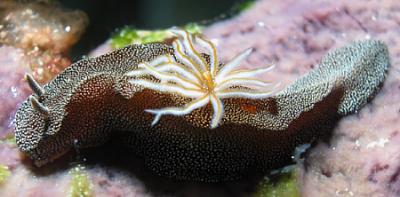
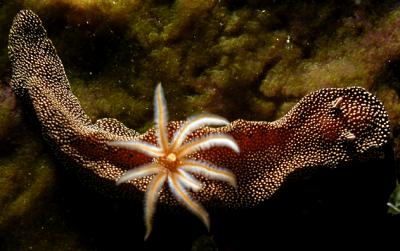
Hi Bill,
I recently did some diving (Jan 2003) at Tufi in Papua New Guniea and I found a couple of nudibranchs that I am unable to identify. I have attached two images that I believe is a Ceratosoma species of some sort.
I found this animal on several occasions on the outer reefs and it was only ever found on a brown/grey soft fan coral which I believe it fed on. The size of the species was generally about 5 - 10cm. Any idea on which species it is?.
Also, I photographed 36 different species of nudibranchs and related species over my 2 weeks there. I have put them on my website at: http://www.webone.com.au/~diving/png
Cheers,
Dave Harasti
diving@webone.com.au
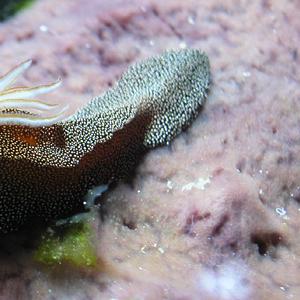
Thanks Dave,
This is Glossodoris stellatus. As I have said on the Fact Sheet for this species, its very reduced mantle skirt does make it look quite like a species of Ceratosoma. It is good to get more photos because we know very little about it. As a chromodorid I am pretty sure it will feed on a sponge rather than a fan-coral. Are these two photos of the animals just as you found them, or did you take them off the corals for the photos? If they are photographed as you found them, then the pinkish growth the upper animal is crawling over, which is a sponge, could possibly be its food sponge.
Another interesting additional piece of information is the orange-brown lines on the gills. Previously I have only seen black lines on the gills.
Cheers,
Bill Rudman
Glossodoris stellatus from Bunaken
May 4, 2002
From: Mirta Moraitis
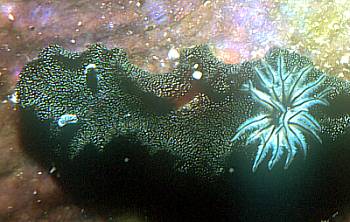
Hallo Bill,
I am a student in marine biology. I've decided to have been studying nudibranch feeding on sponges in NE Sulawesi. One week ago [April 2002] I was at Manado in Bunaken National Park, NE Sulawesi, Indonesia and I've found this strange nudibranch at 20 meters of depth, on a green flat sponge. I've tryed to identify him in many books and according to them it's name is Glossodoris stellatus. I've decided to send you some photos because I didn't find it on the Sea Slug Forum. Can you help me on classifying it please?
Thanks,
Mirta
dipingu@libero.it
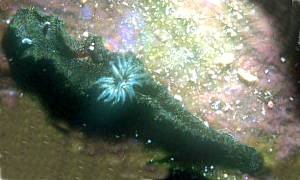
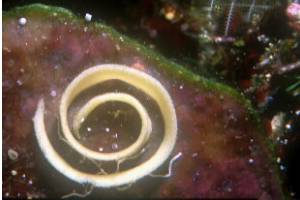
Dear Mirta,
I remember your nice photos of Diaphorodoris papillata from Croatia. Quite a different fauna from Sulawesi. Your animal is Glossodoris stellatus. Sorry you couldn't find it on the Forum. There are still many species to add. You'll be pleased to know that your message has spurred me into adding a page for this species.
Best wishes,
Bill Rudman
